Six Simple Outdoor STEM Activities for Kids
Summer camp is a prime opportunity to get kids engaged with Science, Technology, Engineering and Math (STEM) while they’re outdoors. This exposure helps campers develop 21st century skills while also building equity across gender and racial divides.

Here are six simple activities that any counselor can lead:
1. Natural Artists
Have campers collect materials from nature and create art to share with the group. They may work alone or in pairs to unearth the outdoors. Their art may result in a picture frame, a sculpture, a robot or a mural. Creativity and imagination are encouraged. Ask campers to think through where the materials come from, their role in nature, what the world would be like without them, and the colors, shapes and textures they discovered. What is a habitat and what do these materials tell us about the habitat?
2. I Spy STEM Walk
Take a walk through nature or anywhere outdoors if your camp is in a city. Identify how or where STEM is involved by pointing out science, technology, engineering and math wherever you see it and encourage campers to join in. How do trees stay alive? How are buildings constructed? What lives outdoors versus indoors and why? What do you notice up in the sky? What technology can be found outdoors?
3. Shadow Tracking
Learn all about the movement of the earth by tracking shadows throughout the day. Have students stand in the same spot at various times and mark with chalk on the sidewalk how "tall" their shadow is at each hour. Discuss why our shadows shrink and grow and what that teaches us about the movement of the earth.
4. Earthquake Test
Experiment with foundations by testing various structures on top of different outdoor surfaces (sand, dirt, mud, concrete, water). Challenge campers to create a bridge or building using materials you provide (popsicle sticks, toothpicks, Legos or anything found at your camp), and let them work to figure out how to make it steady. Have a competition to see which structure holds the most weight or withstands an “earthquake.”
5. Water Challenge
Use water games to have youth solve problems as a team. Put campers in groups and challenge them to move a large amount of water from one bucket to another using only a smaller bucket with large holes in the bottom. Let them brainstorm strategies for plugging the holes and keeping as much water as possible in the bucket in order to fill up their large bucket quickly. Have them measure the water and discuss the factors that make them move more or less water.
6. Sink or Float
What makes some materials sink in water while others float? Ask them to make predictions about the sample materials (a penny, tin foil, a Lego, a plastic cup, a spoon) and then ask follow up questions about what patterns they noticed. What do they suspect made some objects float while others sank?




